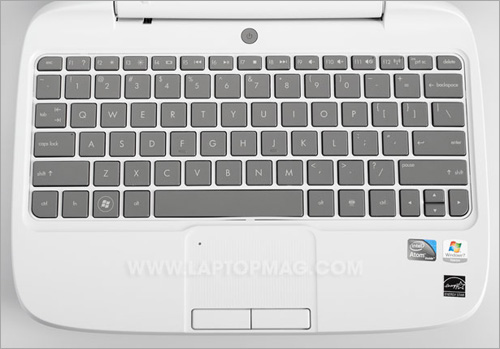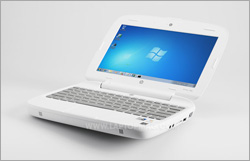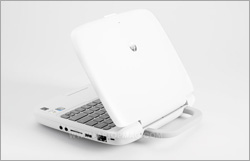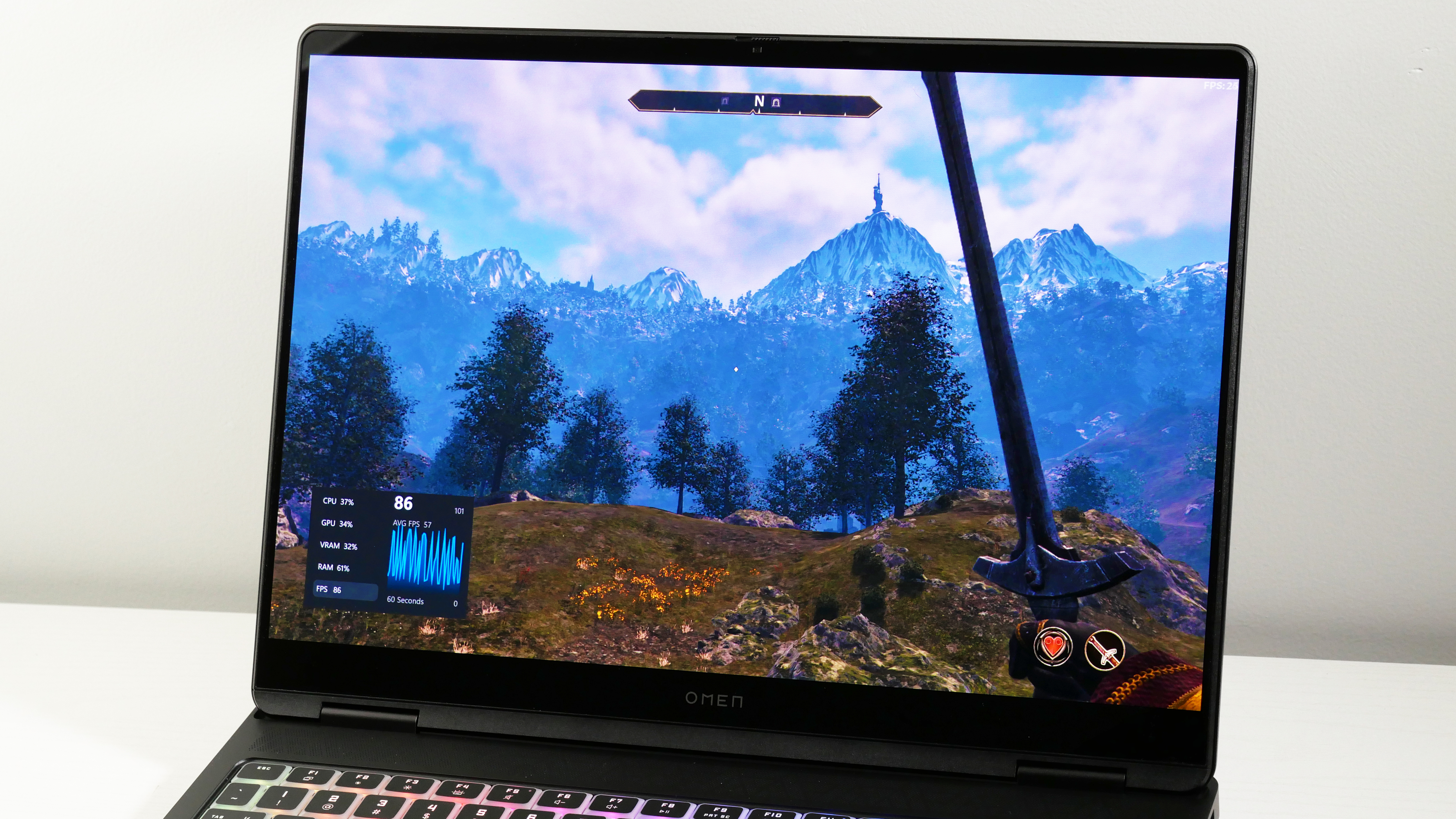Laptop Mag Verdict
This K-6 student netbook is affordable but doesn't always match the performance of similarly priced consumer netbooks.
Pros
- +
Good keyboard and touchpad
- +
Includes modem port for students without broadband access
- +
Long battery life
- +
Runs very cool
Cons
- -
Isn't as rugged and kid-proof as other student netbooks
- -
Light on included education-based software
- -
Mediocre performance
Why you can trust Laptop Mag
Student-focused mini laptops are what started the netbook category back in 2007. The dream of low-cost, durable machines for kids in the U.S. as well as emerging markets isn't dead, and HP's newest offering embodies both goals. The sub-$300 HP Mini 100e won't be available to consumers in the U.S., only to school systems, but for those lucky students it offers decent performance and long battery life for a good price. Is it a better choice than other student-focused offerings or inexpensive mass-market models?
Design
This 10.9 x 9.9 x 1.6-inch, 3.4-pound unit is thicker and heavier than the average netbook, though sleek and slim isn't necessarily a virtue in the student-focused netbook arena. The overall design employs rounded curves and a durable, white matte plastic chassis. The lid is plain except for a small, tasteful HP logo and a small LED light near the top that activates when the system is connected to the Internet; this feature helps teachers monitor network usage. Even though it is thick, the 100e doesn't feel bulky or look clunky. HP achieves an attractive and elegant (if plain) aura.
What's more important is how well it can stand up to rigorous use and abuse by kids who perhaps haven't yet learned how to take care of expensive electronics. To that end, HP has included some features to mitigate damage, such as a spill-resistant keyboard and a large carrying handle to lower the risk of dropping it. Other options include a hard drive accelerometer, which will park the needle if it senses a sudden tumble.
Though the netbook does exude sturdiness, we prefer the overall design of the extra-kid proof CTL 2go Convertible Classmate PC NL2. The CTL 2go netbook includes rubberized coating on the outside, reinforced edges, a scratch-resistant display, and an anti-microbial coating on the keyboard and touchpad.
Keyboard and Touchpad
The island-style keys are a good size and should be comfortable for both students and their parents. HP kept the keyboard as similar as possible to traditional netbooks, including key placement along the edges. The Shift, ALT, CTRL, and Fn keys are all in their normal positions, so kids learning to type won't have to make any strange adjustments when they move to full-size keyboards. We appreciated the small LEDs embedded in the Caps Lock, F11/Volume Mute, and F12/Wi-Fi keys that indicate when they're active.

Click to enlarge
Our only issue with the keys is that they sometimes required more deliberate taps than touch typists are used to. Every now and then a letter or two was dropped while typing at our normal rate. However, this would likely be beneficial to students learning to type, as it would encourage accuracy before speed.
The roomy 2.5 x 1.5-inch touchpad employs raised dots reminiscent of ASUS Eee PC Seashell models to help with tracking. But the surface on the 100e is softer, so while the effect is the same, the tactile sensation isn't as harsh as on the Eee PC. The two discrete mouse buttons along the bottom could be bigger but are about the right size for small fingers, and they offered snappy return.
Heat
One benefit of the Atom processor inside the 100e is that it keeps temperatures down. To test this, we played a Hulu clip at full screen for 15 minutes, then measured three key areas of the netbook. The touchpad reached only 75 degrees Fahrenheit, the space between the G and H keys measured 84 degrees F, and the middle of the underside stayed a relatively cool 89 degrees. Each of these is at or below the acceptable temperature zone, so parents won't have to worry about letting kids use these netbooks on their laps for long periods.
Display and Audio

Click to enlarge
The Mini 100e's 10.1-inch, 1024 x 600 matte display has extremely wide horizontal and vertical viewing angles, so a small group of students should be able to share a screen without encountering distortion or obfuscation. The netbook handled a 720p trailer for "The Discoverers" without dropping frames. Not only are colors nice and deep, but the netbook handled languid motion and transitions from light to dark well.
The audio quality isn't powerful, but given the small speakers on the front edge of the system, this is no surprise. While watching an episode of "The Closer" on TNT.tv (where the audio tends to be softer, just as with Hulu) we had to turn the volume up to 100 percent and still had a hard time hearing softer scenes over the air conditioner on low in the background.
Ports and Webcam
Most of the ports found on the 100e are typical for any netbook--VGA, Ethernet, memory card, headphone, and mic--with two notable differences. First, there are only two USB 2.0 ports, while most systems have three. It leaves room for what many would consider an anachronistic addition: a modem port. HP included this port for students who may not have Internet or high-speed broadband access at home. This way, they can still connect via a dial-up ISP, or dial in to the school's servers to download assignments. The 100e also includes a lock slot so they can be kept secure in the classroom environment.

Click to enlarge

Click to enlarge
The integrated VGA webcam produced decent images, but they tended to be dark in rooms with bright fluorescent lights overhead. It captures colors fairly well when the backlight doesn't overwhelm, and we had to move pretty quickly to start seeing blurriness in video. However, we wish that the 100e employed a swivel for the webcam similar to the CTL 2go PC NL2 so that students had a wider range of shots available to them.
Performance
The HP Mini 100e is equipped with Intel's Atom N455 (1.66-GHz) and 1GB of RAM. It earned a score of 1,330 on PCMark05, which is almost 100 marks below the netbook average, and below the $299 Toshiba Mini NB255 (1,393), which has the same processor. It was also outscored by the $299 ASUS Eee PC 1001P, which has an older N450 CPU (1,384). In Geekbench the 100e fared better with a score of 913. Though still behind the Mini NB255 (927), it's just ahead of the 1001P (908) and comfortably ahead of the CTL 2go PC NL2 (848).
The 160GB, 5,400 rpm-hard drive isn't a speed demon, completing the LAPTOP File Transfer Test in 4 minutes and 46 seconds for a score of 17.8 MBps. This is on a par with the Eee PC 1001P (17.5 MBps) but below the NL2 (24.5 MBps), the NB255 (23.2), and the category average (18.0 MBps).
Students probably won't be called on to do much video transcoding. But if they want to do more with their webcam videos, the 100e can handle the task slightly better than most netbooks. It took the system 5 minutes and 57 seconds to transcode a 5:05 MPEG-4 video clip (114MB) to the AVI format using Oxelon Media Converter; faster than the CTL 2go (8:29), the Eee PC (6:02), and the NB255 (6:06).
With Intel's integrated Graphics Media Accelerator HD on board we didn't expect Ion-level power, but the 3DMark06 score of 149 puts the system on equal footing with the CTL 2Go PC NL2 (150) and the Eee PC (155).
Standard def and 720p HD video stored on the hard drive played smoothly in Windows Media Player. Though when we played Flash video from Hulu, the result was very slideshow-like, even when not at full screen. Videos on TNT.tv played smoother, and there were far fewer dropped frames when watching episodes of "Xena: Warrior Princess" and "Murder, She Wrote" on Netflix (which uses Microsoft Silverlight instead of Flash).
Battery and Wi-Fi
The Mini 100e's 6-cell battery lasted for 6 hours and 32 minutes during the LAPTOP Battery Test, right at the 6-cell netbook average and less than 10 minutes behind the NB255 (6:41). The Eee PC 1001P is still the champ of low-cost netbooks (8:40), but 6 and a half hours is likely more than most students will need since they will mostly use the 100e during class. However, it's good that the netbook will last through most long car trips.
At 15 feet from the router, the Realtek RTL8191SE 802.11 b/g wireless radio delivered a strong throughput of 32.8 Mbps, but at 50 feet the signal dropped to 17.9 Mbps. Though less powerful than the CTL 2go up close (37.4 Mbps), the 100e is a bit stronger at a distance. It beats the Eee PC 1001P at 15 feet (20.3 Mbps) but not at 50 (19.3 Mbps); and the Toshiba mini NB255 is stronger all around (38.4/23.7 Mbps).
Green Tests
This netbook is also fairly green, taking only 2 hours to charge to 80 percent and another 58 minutes to get to full capacity. During this time the 100e used an average of 25 Watts for a Battery Efficiency Rating of 11.4. This makes the system very green, coming in under the netbook average (15.7), the CTL 2go (17.9), and the Mini NB255 (18.3); the Eee PC is lower still with a score of 8.2. EPEAT gave the Mini 100e a rating of 20.
Software
The included software is typical for a Windows 7 netbook with a few extras geared toward students. HP preloads Evernote, a note-taking suite that syncs to the cloud and other notebooks; PDF Complete reader with an optional upgrade to editor; and Win-Zip. Shipped units will also include Microsoft Math, a program that helps K-6 students solve equations with step-by-step guidance.
The 100e also includes Microsoft Office 2010 Starter. The pared-down versions of Word and Excel have enough functionality for younger students and will help keep costs down for school systems, given that Starter is completely free and not just a 60-day trial. Plus, students will have access to the Windows Live suite of programs (Movie Maker, Writer, Photo Gallery). They'll also be able to take snapshots and record video with ArcSoft's Webcam Suite.
Microsoft's free Security Essentials also comes preloaded, which should protect against any viruses kids might pick up while surfing the net.
While the Mini 100e's software load is by no means sparse, the CTL 2go PC NL2 offers a few more programs out of the box, including Art Rage 2 (much more fun than Windows Paint) and the Blue Dolphin user interface, a kid-focused overlay that makes interacting with Windows 7 more entertaining.
Configurations and Warranty

Click to enlarge
School systems have a small range of configuration options available to them, mostly on the software side. Other than Windows 7 Starter Edition, HP will also preload Windows XP (which may offer slightly faster performance) or SUSE Linux Enterprise on the 100e. HP will make other education-focused software available to school systems depending on their needs, including classroom management tools.
Two battery sizes are available: 6-cell and 3-cell. If the netbooks will remain in one classroom most of the time, the shorter battery life of the 3-cell option won't matter as much. But if students are going to carry them from class to class, the 6-cell battery is the better choice. Hard drive accelerometers are also available, which will lessen damage from accidental drops and bumps.
The pricing for these upgrades and additions will vary depending on the school system and number of units. HP did not provide any cost details to us.
HP offers a limited one-year warranty on the netbook and the battery, with optional HP Care Pack Services available for extra.
Verdict
Unit price depends on the number of systems ordered, but HP estimates that the Mini 100e will cost less than $300. So while the Mini 100e may not offer as robust a package as the CTL 2go Convertible Classmate PC NL2, it will cost anywhere from $100 to $200 less, which is a pretty steep delta for large, cash-strapped schools. And even though consumer models like the ASUS Eee PC 1001P and the Toshiba Mini NB255 cost about the same (and, in some cases, perform better), they don't include the kid-proofing and durability that will keep you from having to replace a unit after the first minor accident. For the price, the Mini 100e is a good choice for schools and students.
K. T. Bradford writes about laptops, apps, and ebook readers for Laptop Mag. She has written reviews of some of the most iconic laptops from the last decade and more, covering models such as the Acer Aspire One, the Samsung R580, and the Lenovo IdeaPad S205. Some of her other reviews include MSI, HP, Dell, and Asus notebooks.
